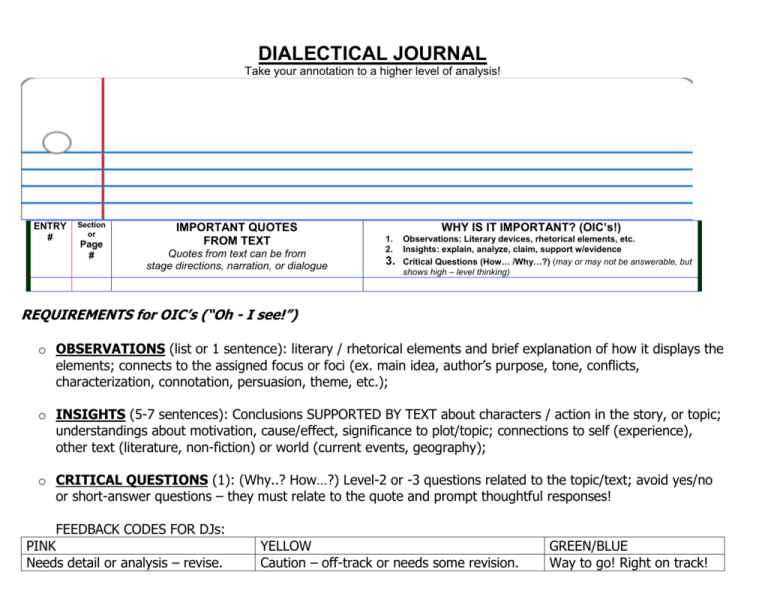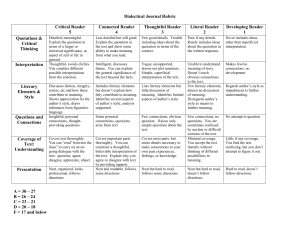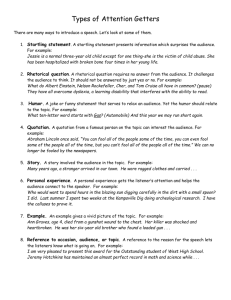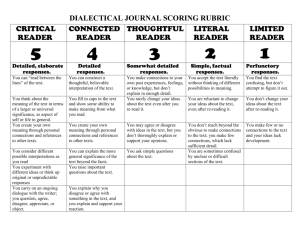CODES FOR DIALECTICAL JOURNAL FEEDBACK
advertisement

DIALECTICAL JOURNAL Take your annotation to a higher level of analysis! ENTRY # Section or Page # IMPORTANT QUOTES FROM TEXT Quotes from text can be from stage directions, narration, or dialogue WHY IS IT IMPORTANT? (OIC’s!) 1. 2. 3. Observations: Literary devices, rhetorical elements, etc. Insights: explain, analyze, claim, support w/evidence Critical Questions (How… /Why…?) (may or may not be answerable, but shows high – level thinking) REQUIREMENTS for OIC’s (“Oh - I see!”) o OBSERVATIONS (list or 1 sentence): literary / rhetorical elements and brief explanation of how it displays the elements; connects to the assigned focus or foci (ex. main idea, author’s purpose, tone, conflicts, characterization, connotation, persuasion, theme, etc.); o INSIGHTS (5-7 sentences): Conclusions SUPPORTED BY TEXT about characters / action in the story, or topic; understandings about motivation, cause/effect, significance to plot/topic; connections to self (experience), other text (literature, non-fiction) or world (current events, geography); o CRITICAL QUESTIONS (1): (Why..? How…?) Level-2 or -3 questions related to the topic/text; avoid yes/no or short-answer questions – they must relate to the quote and prompt thoughtful responses! FEEDBACK CODES FOR DJs: PINK Needs detail or analysis – revise. YELLOW Caution – off-track or needs some revision. GREEN/BLUE Way to go! Right on track! Dialectical Journal Rubric Critical Reader 5 POINTS: Connected Reader 4 Thoughtful Reader 3 Quotations & Critical Thinking (overview) Detailed, meaningful; uses academic language to explain the quotation in terms of a universal significance, as aspect of self or life Less detailed, but still meaningful. Explains the quotation in the text and shows some ability to make meaning from what you read. Literary / Rhetorical Elements & Style (Observations) Identifies several rhetorical/style elements, connects them to the insights in an academically insightful, interesting way Identifies some rhetorical / style elements and analyzes them in some depth in the insights Lists required elements, but incudes little discussion of their meaning in the text Interpretation (Insights) Uses academic language to discuss ideas in depth; avoids clichés; Uses academic language to analyzes the “so what?”, “why?” and discuss ideas in some depth; “how?” of the text; analyzes the “so what?”, Makes high-level connections to self, “why?” and “how?” of the text, and world; text; considers different Makes some connections to possible interpretations or self, text, or world; perspectives from the selection. Uses vague language to discuss ideas in some depth; lacks analysis of the “so what?”, “why?” and “how?” of the text; Makes few connections to self, text, or world; Simple, superficial interpretation of the text. Questions and Connections (CQs) Uses academic language to produce Insightful, text-text, text-self, textworld connections, thought- provoking Level-2 or -3 question that prompts high-level response; Coverage of Text: Analysis Presentation Covers text thoroughly. Uses academic language to “read” between the lines” to carry on an ongoing dialogue with the text: question, agree, disagree, appreciate, object Neat, organized, looks professional; clearly legible and marked; follows or goes beyond the scope of the assignment TOTAL: ______ / 50 REFLECTIONS / COMMENTS: Uses academic language to produce personal connections, thoughtprovoking Level 2 or 3 question that prompts academic response; Literal Reader 2 Poor, if any details. Few good details. Trouble including ideas about Rarely includes ideas the quotation in about the quotation in context the written response. Developing Reader 1 Includes few ideas other than summary or superficial interpretation. Few elements, almost no discussion of meaning. Disregards author’s style as means to further meaning. Regards author’s style as impediment to further understanding. Unable to understand meaning of story; summarizes, and doesn’t reach obvious connections to the text Makes few/no connections, no development Few to some general Obvious question, few connections, to no connections. Level 1 or low-level 2 (obvious Sometimes confused to simple) question about the by unclear or difficult text. sections of the text. No attempt to question or make connections Covers important parts; Constructs a thoughtful, believable interpretation of the text. Explain why you agree or disagree with text by providing support. Covers most parts, but omits details necessary to make connections to your own past experiences, feelings, or knowledge. Minimal coverage. You accept the text literally without thinking of different possibilities in meaning. Little if any coverage. Text is confusing, and little effort is shown in trying to figure it out. Neat and readable; Follows most directions of the assignment; Somewhat difficult to read, follows some directions Difficult to read, doesn’t follow directions Illegible; doesn’t follow directions

![Program`s Dynamic Criteria Map (DCM)[1]](http://s3.studylib.net/store/data/007112770_1-0a2faad44b8e94d6ea99c5f4cbf00e83-300x300.png)





